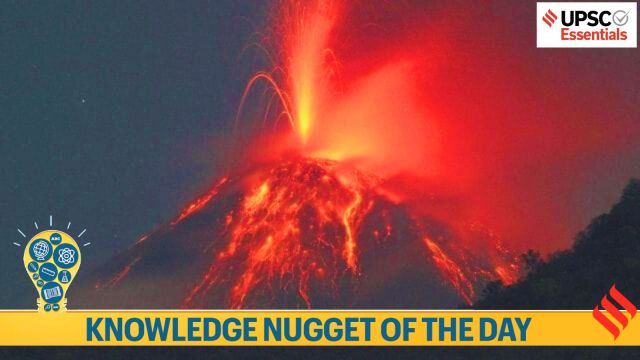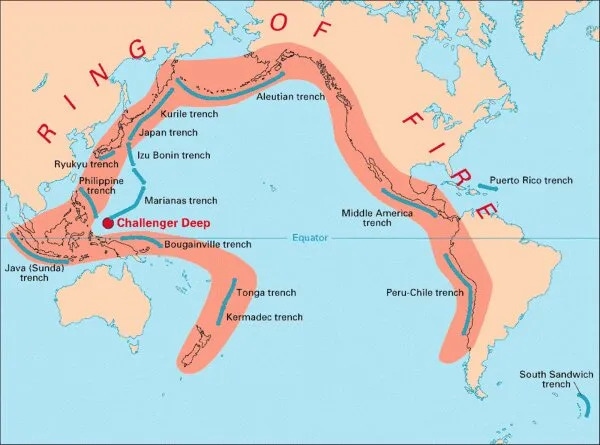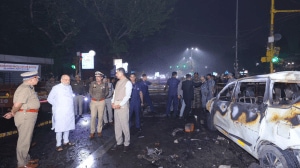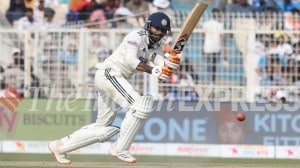
Why in the news?
At least seven international flights from Indonesia’s resort island Bali have been cancelled, an airport official said on Friday, after Mount Lewotobi Laki-Laki, a twin-peaked volcano on Indonesia’s Flores Island, erupted on Thursday (March 20), prompting authorities to raise its alert status to the highest level.
Story continues below this ad
The same volcano erupted in November, killing at least nine people and displacing thousands. Indonesian authorities had planned permanent relocations for affected residents, though the number impacted by Thursday’s eruption is still unknown. In this context, let’s know what volcanoes are and their different types.
 Mount Lewotobi Laki-Laki spews volcanic materials into the air in East Flores, Indonesia Friday, March 21, 2025. (AP Photo/Ester Narek)
Mount Lewotobi Laki-Laki spews volcanic materials into the air in East Flores, Indonesia Friday, March 21, 2025. (AP Photo/Ester Narek)
Key Takeaways :
1. According to the US Geological Survey”Volcanoes are openings, or vents where lava, tephra (small rocks), and steam erupt onto the Earth’s surface”.
2. Volcanoes can be on land and in the ocean. They are formed when material significantly hotter than its surroundings is erupted onto the surface of the Earth. The material could be liquid rock (known as “magma”, when it’s underground and “lava” when it breaks through the surface), ash, and/or gases.
3. The rise of magma can take place in three different ways, according to NASA.
Story continues below this ad
(i) First, when tectonic plates — massive, irregularly shaped slabs of solid rock that carry both continents and oceans and are constantly in motion — move away from each other. “The magma rises up to fill in the space. When this happens underwater volcanoes can form,” it added.
(ii) Second, when the plates move towards each other. “When this happens, part of Earth’s crust can be forced deep into its interior. The high heat and pressure cause the crust to melt and rise as magma,” NASA said.
(iii) Third is how magma rises at the hotspots — hot areas inside of the Earth, where magma gets heated up. As magma gets warmer, it becomes less dense, leading to its rise.
Types of Volcanoes
1. There are four main types of volcanoes: cinder cones, composite or stratovolcanoes, shield volcanoes and lava domes.
Story continues below this ad
2. Their type is determined by how the lava from an eruption flows and how that flow affects the volcano, and, as a result, how it affects its surrounding environment.
Can scientists predict volcanic eruptions?
1. Scientists are capable of predicting volcanic eruptions hours, or sometimes several days, in advance. This isn’t the case with earthquakes, which are much harder to predict. Scientists use seismographic data from earthquakes and other tremors, because those can be a precursor to volcanic eruptions.
2. They monitor the ground for signs of deformation, which may be caused by the movement of magma. They also take readings of volcanic gas emissions, and changes in gravity and magnetic fields.
Volcanoes particularly active in Pacific Ring of Fire
1. The Ring of Fire is essentially a string of hundreds of volcanoes and earthquake-sites which runs along the Pacific Ocean. It is a semicircle or horse shoe in shape and stretches nearly 40,250 kilometres. Some of the most active volcanoes are located in the Pacific Ring of Fire, which includes New Zealand, Southeast Asia, Japan and the western coast of the Americas. About 90% of all earthquakes worldwide strike within this region.
Story continues below this ad
 The map of the Pacific Ring of Fire. (Credit: USGS)
The map of the Pacific Ring of Fire. (Credit: USGS)
2. The Ring of Fire traces the meeting points of numerous tectonic plates, including the Eurasian, North American, Juan de Fuca, Cocos, Caribbean, Nazca, Antarctic, Indian, Australian, Philippine, and other smaller plates, which all encircle the large Pacific Plate, according to a report by National Geographic. It runs through 15 more countries including the USA, Indonesia, Mexico, Japan, Canada, Guatemala, Russia, Chile, Peru, and the Philippines.
BEYOND THE NUGGET: Some famous volcanoes
Any volcano that has erupted within the Holocene period (in the last 11,650 years) is considered to be “active” by scientists. “Dormant” volcanoes are those active volcanoes which are not in the process of erupting currently, but have the potential to do so in the future. “Extinct” volcanoes are ones which scientists predict will never face any further volcanic activity. Ben Nevis, the tallest mountain in the UK, is an extinct volcano. Here are some famous volcanoes in the world.
1. Mauna Loa, Hawai: It is one of five volcanoes that together make up the Big Island of Hawaii, which is the southernmost island in the Hawaiian archipelago. It’s not the tallest (that title goes to Mauna Kea) but it’s the largest and makes up about half of the island’s land mass. It sits immediately north of Kilauea volcano.
2. Kilauea volcano, Hawai: Adjacent to the Mauna Loa, this is one of the most active volcanoes on the planet. Kilauea made headlines last December when it started to erupt, spewing lava and volcanic gas. It is a major tourist attraction, with the earliest hotel built at the edge of the volcano in the 1840s.
Story continues below this ad
3. Fagradalsfjall volcano, Iceland: On December 18, 2023, an eruption began west of Fagradalsfjall, about 50 km (30 miles) south of the capital Reykjavik (Iceland). It spewed lava and smoke more than 100 meters (330 feet) into the air, following weeks of seismic activity.
4. Mount Etna, Italy: Sometimes referred to simply as Etna, Mount Etna is an active volcano on the east coast of Sicily, the largest island in the Mediterranean Sea, lying just off the toe of the Italian “boot”. Etna’s peak is the highest in Italy south of the Alps, and it is Europe’s largest and one of the most active volcanoes. Etna’s summit has five craters, which are responsible for most of the volcano’s eruptions; there are also “flank” eruptions that occur out of 300-odd vents of varying sizes along the slopes of the mountain.
Etna has been a World Heritage Site since 2013, and according to UNESCO, the volcano’s eruptive history can be traced back 500,000 years. At least 2,700 years of this activity has been documented.
5. Eyjafjallajökull, Iceland: Sometimes referred to as E15, it is one of the many volcanic features of Iceland. In 2010, a relatively small eruption managed to bring air traffic in Europe to a complete standstill. 20 countries closed their airspace, impacting approximately 10 million travellers.
Story continues below this ad
6. Mount St Helens, USA: Located in Washington State, Mount St. Helens was a major eruption that occurred on May 18, 1980, and it remains the deadliest and most economically destructive volcanic event in U.S. history. It remains an active volcano and one that is considered to be amongst the riskiest by scientists.
Post Read Questions
(1) Which of the following are the products of volcanic eruptions?
1. Sulphur compounds
2. Ash and dust
3. Helium gas
4. Pyroclastic debris
5. Argon gas
Select the correct answer using the codes given below:
(a) 1, 2 and 3 only
(b) 1, 3, 4 and 5
(c) 1, 2, 4 and 5
(d) 1, 2, 3, 4 and 5
(2) Consider the following statements: (UPSC CSE 2018)
1. The Barren Island volcano is an active volcano located in the Indian territory.
2. Barren Island lies about 140 km east of Great Nicobar.
3. The last time the Barren Island volcano erupted was in 1991 and it has remained inactive since then.
Which of the statements given above is/are correct?
(a) 1 only
(b) 2 and 3 only
(c) 3 only
(d) 1 and 3 only
Story continues below this ad
(Sources: A Sicilian volcano is blowing smoke rings in the sky. What are volcanic vortex rings?, Mauna Loa volcano in Hawaii erupts: What is the science behind volcanic eruptions?, Why some volcanoes just keep spewing lava,Volcano in Iceland erupts: Why is the country so volcanically active?)
🚨 Click Here to read the UPSC Essentials magazine for March 2025. Share your views and suggestions in the comment box or at manas.srivastava@indianexpress.com🚨
Subscribe to our UPSC newsletter and stay updated with the news cues from the past week.
Stay updated with the latest UPSC articles by joining our Telegram channel – Indian Express UPSC Hub, and follow us on Instagram and X.



 Mount Lewotobi Laki-Laki spews volcanic materials into the air in East Flores, Indonesia Friday, March 21, 2025. (AP Photo/Ester Narek)
Mount Lewotobi Laki-Laki spews volcanic materials into the air in East Flores, Indonesia Friday, March 21, 2025. (AP Photo/Ester Narek) The map of the Pacific Ring of Fire. (Credit: USGS)
The map of the Pacific Ring of Fire. (Credit: USGS)






























